Data Analysis
For the purpose of the data analysis portion of this study, an examination of one primary source which surveyed Muslim Americans will be conducted. The source of the data being examined is the article “Muslim Americans: No Signs of Growth in Alienation or Support for Extremism,” which was conducted by the Pew Research Center. This survey targeted 1,033 Muslim Americans that were aged 18 years old and older. It examined various aspects related to social concerns, identity, community orientation, and political affiliation. The survey also delved into aspects related to political participation and concerns the Muslim American population had after 9/11. It is anticipated by the researcher that through this research analysis, the writer will be able to come up with a definitive conclusion regarding the extent of American Muslim participation in politics and how it correlates with the involvement of mosques. The first hypothesis that will be utilized to guide this examination is:
- The majority of American Muslims participate in the affairs of politics because they believe in democracy and its values.
While the second hypothesis is:
- The mosque has a great investment in organizing and encouraging American Muslims to participate in politics.
Examining Political Participation
Based on the data from the Pew Research center, it can be seen that most Muslim Americans (constituting 70 percent of the population) identify themselves either as Democrats (46 percent of the population), or either has a political orientation that leans towards the Democratic Party in general (constituting 24 percent of the population) (Pew Research, 2011). Do note, though, that just because a person states that they are a Democrat or lean towards the Democratic Party does not mean that they are politically active. It is based on this that this section will attempt to determine whether Muslims who do not attend mosque services are still politically active or if such a predilection is isolated towards mosque attendees only. By doing so, this paper will be able to establish the impact of mosque influence on political participation.
Correlating Civic Engagement and Mosque Attendance with Political Participation
It is the hypothesis of this study that mosques make a difference when it comes to political participation. In order to prove this point, the following analysis has been conducted utilizing data from the Pew Research Center. In this section, three variables are being examined, namely: political participation (dependent variable), civic engagement (dependent variable), and mosque attendance (independent variable).
As it can be seen in the data results of the study, there is a ratio between political participation (0.091) with mosque attendance (0.091) with a Sig. a score of 0.25 for both variables. What this is indicative of is that there is a connection between higher rates of mosque attendance with the likelihood of an American Muslim engaging in political participation. Also, when it came to aspects related to civic engagement and its correlation with mosque attendance and political participation, it was shown that there was a distinct correlation with higher rates of civic engagement (0.141) with a person attending the mosque and engaging in political participation. While it is not quite clear whether civic engagement results in higher rates of mosque attendance, which causes a person to participate more actively in local politics, it can be stated that there is a definite relationship between the three variables wherein one leads to the other.
It is likely that through the influence of the mosque on their respective congregations, this causes American Muslims to engage more in local civic engagement as well as participate in politics in order to contribute towards positive societal effects within their respective communities. To back up such a claim, studies such as those by Ayers & Hofstetter (2007) state that there is substantial reason to believe that attendance to religious functions does impact political participation due to the way in which congregations are influenced not only by the views of their religious leaders but also by other people at attendance. What Ayers & Hofstetter (2007) implied is that since churches and mosques are basically places where people congregated, there is reason to believe that this creates a situation where large numbers of people can be influenced through either sermon or through interactions with the people they meet (Ayers & Hofstetter, 2007).
Gender, Mosque Attendance, and Political Participation
Another way in which this study will attempt to justify the view that mosques make a difference in political participation is by examining the attendance rate of Muslim men and women. In this section, what will be done is an examination of the independent variable of Mosque attendance with the dependent variable of gender.
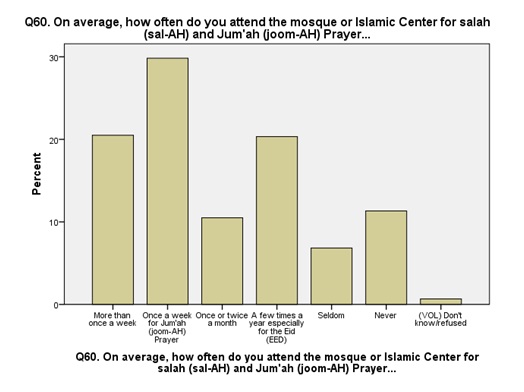
Gender
Correlations
As can be seen in the examination conducted above, there is a positive correlation between gender and political participation with a score of 0.172. The same can be said between gender and civic engagement. What this is indicative of is that there are gender factors that influence the rate of political participation resulting in greater political participation based on gender. In order to better understand how these variables contribute towards indicating that mosques do make a difference in political participation, data from the Pew research center will be examined to determine what factors inherent in gender variables influence rates of political participation. As seen in the Pew research data, 57 percent of Muslim men state that they attend the religious services of the mosques on a weekly basis as compared to only 32 percent of Muslim women (Pew Research, 2011).
Comparatively, when examining the rate of political participation of genders within the American Muslim population, it can be seen that 67 percent of males participated as compared to only 32 percent of females (Pew Research, 2011). While this is not definitive proof of the impact that is actively attending a mosque has on political participation, it does show that there is some correlation in place. Based on the data provided, it can be seen that 47 percent of American Muslims attend religious services at their local mosque at least once a week, while 34 percent state that they attend services once or twice a month. The remaining 19 percent state from the survey stated that they rarely or never attend mosque services (Pew Research, 2011). One of the assertions that this study sought to explore ways to investigate the degree of female American Muslim participation as influenced by the mosque. What the Pew Research data showed was that female participation among Muslim Americans was considerably lower as compared to their male counterparts. Since this study has shown so far that participation in the mosque can be correlated with greater political participation, then the lower levels of female Muslim participation may be due to fewer female Muslims attending the various prayers and sermons at the mosque.
The Pew Research Center article showed that only 37% of Muslims that attend mosque services were women (Pew Research, 2011). What these statistics hint towards is that since participation in the various religious rites and services of a mosque leads to greater levels of political participation among the attendees, then it can be stated that since there are relatively few Muslim women that attend such services, it is not surprising then that few female Muslim Americans delve into political participation. While lower female participation in politics can at times be dismissed by the inherent values found in a particular religion or culture, the fact remains that the data does show evidence that there are more males than females that attend mosque services and that there are more males than females that engage in political participation. Thus, based on this data and the statistical examination that was conducted, it can be stated that attendance in mosques does have an impact on civic engagement and political participation wherein greater rates of mosque attendance result in higher rates of political participation and civic engagement and vice versa. Thus, it can be hypothesized from this data that the more one attends mosque services, the greater the likelihood that they would engage in political participation. This data adds more substance to the initial argument of this paper that mosques do, indeed make a difference.
Income Level and Political Participation
In this section, what will be examined is whether an individual’s income level impacts their overall level of political participation. It should be noted, though, that when examining the rate of political participation (i.e., those that are registered to vote and those that actually voted. Income levels of different American Muslims actually show a relatively minor difference. For example, American Muslims that earn $75,000 or more have a participation rate of 78 percent; those that earn $30,000 to $74,999 have a rate of 68 percent, while those that earn less than $30,000 have a rate of 60 percent. While there is a substantial difference of at least 20 percent between high and low-income earners, the fact remains that across all levels of income, the American Muslim population continues to show relatively high numbers in terms of political participation. The same can be said for those that are native or foreign, with those who are native-born having a participation rate of 66 percent and those that are foreign-born having a participation rate of 67 percent. What this shows is that regardless of origin or income level, there are high rates of political participation across various categories.
Correlations
2-Income level
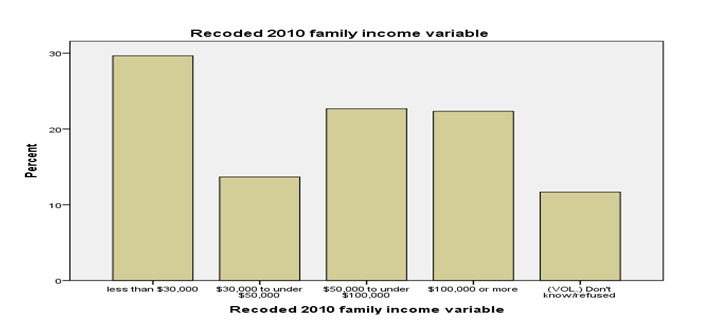
Based on the examination shown above, it can be seen that there is a correlation between income level and political participation, however, it should be noted that based on the data from the Pew Research Institute, the relationship between the two variables is inversely proportional in that higher levels of political participation come hand in hand with higher levels of income. On the other end of the spectrum, though, it was shown that there is little correlation between higher levels of income and civic engagement. What this indicates is that while income does influence the rate of political participation, it is not necessarily an influencing factor since that civic engagement, which normally is associated with high rates of political participation, as seen in the previous sections, is shown to be relatively low.
Level of Education and its Impact on Political Participation and Civic Engagement
Correlations
1-Education level
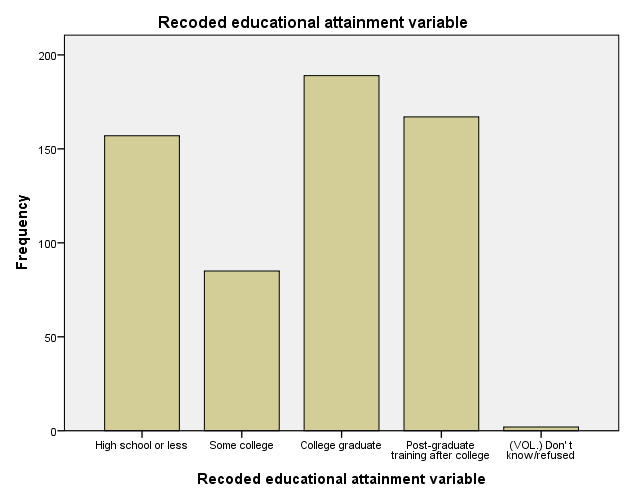
Based on the examination that was conducted, it can be seen that an American Muslim’s education level does not impact the rate in which they engage in political participation or civic engagement. It was shown that when correlated with an individual’s level of education, rates of political participation and civic engagement were -0.203 and -0.153, respectively. This is indicative of very little correlation between what sort of schooling an individual was able to achieve and their predilection to participate in the political process. This is indicative of the fact that there must be other means by which American Muslims become more politically involved.
Muslim belief in democracy and way of life
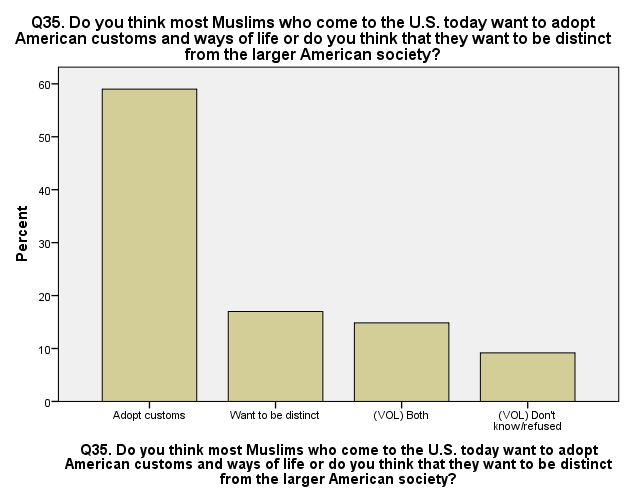
In this section, it was examined whether American Muslims wanted to adopt American customs and the general way of life of the local society. It was shown that American Muslims did indeed want to adapt to the local way of life, and this was also evidenced by data from the Pew Research report regarding voter participation. Through the research report, it was noted that nearly 66% of registered American Muslim voters within the U.S. actually voted and participated in the political process (Pew Research, 2011). However, it should be noted that the respondents in the Pew research article mentioned that life became more difficult for American Muslims as a direct result of the September 11 attacks. While they all stated that most of their encounters with people were friendly since a lot of their neighbors understood that most Muslims were not like that, the fact remained that there a certain level of discrimination when it came to traveling as well as in certain sectors of the community. It is based on this that when taking into consideration their desire to adapt to the local culture and way of life, one way of doing so would be to participate in local politics. Unfortunately, there is no conclusive evidence to support this assertion. However, it can be hypothesized though that this inherent desire to adapt and to be more accepted into local communities could be fostered and developed by local mosques so as to develop the desire to participate more in local political processes such as voting.
Measuring Political Participation
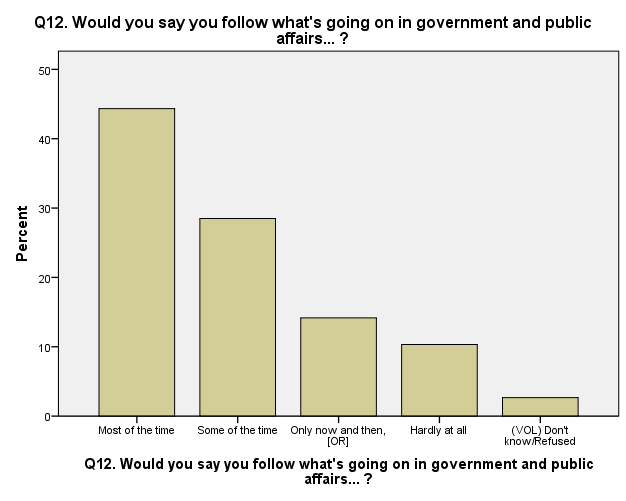
In this aspect of the study, what was measured was the general political participation of the participants. What was revealed was that roughly 70% of the respondents did participate in politics in varying degrees, with the remaining 30 percent rarely did so or not at all. What this shows is that there is a generally high rate of political participation among the Muslim American population. This analysis is backed up by that of the Pew Research center, which states that 73 percent of Muslim Americans that are aged 40 to 54 are registered to vote and increased to 79 percent and higher for individuals that are 55 percent and older (Pew Research, 2011). Comparatively, only 55 percent of those that are 18- 29 years old are registered to vote as well as only 66 percent for those that are between the ages of 30 to 39 (Pew Research, 2011). This is indicative of a relatively high level of registered voters within the American Muslim population. Based on the data from the previous sections of this study, it can be hypothesized that one of the reasons behind this high rate of political participation is due to the influence of mosques, which help to encourage members of their local congregation to engage in local political activities such as voting.
Worked with other people from your neighborhood to fix a problem or improve a condition in your community.
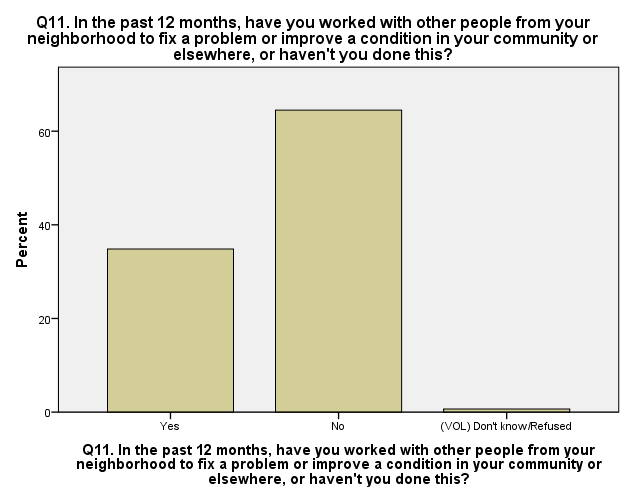
Based on this examination of the data, it can be seen that only 30% of the American Muslim population actively participate in community relations. The remaining 60% do not look at all, while the rest do not know. What this indicates is that American Muslims do not have a direct inclination towards participating in local community relations, rather, it could be that they are convinced to do so by their local mosques.
Conclusion
Through the analysis that was conducted in this paper, the hypothesis that the extent of American Muslim participation in politics is high as a result of the involvement of mosques has been proven to be correct. This was shown wherein attendance to mosques was correlated with higher rates of political participation. Other factors that were utilized in this examination to determine whether this was an accurate examination utilized income levels, gender, level of education and civic participation in order to determine whether these variables would also contribute to greater political participation. It was revealed through the examination that while such factors do have some correlation with increased levels of political participation, it was determined by this study that they were the result of and not necessarily the cause of increased political participation. It is more accurate to state that the influence of the mosque resulted in such variables manifesting themselves as a direct result of the actions undertaken by the respective mosques within the U.S. to convince its members to become more active in local politics. It is based on this that this study can conclude that its initial assumptions were correct in that mosques within the U.S. do indeed make a difference when it comes to political participation.
It is incorrect to believe thought that it is the mosques themselves are the main reason for participation. This particular predilection is not limited to mosques but can also be seen within the context of church groups and how they support Christian candidates in politics. The churches themselves do not participate; rather, the priest says sermons which help to influence the congregation and advocacy groups take over from there. This “grassroots” system of politics has been a feature of the American political system for quite some time so it is not that surprising that it is also present within America’s mosques as well.
Another of the initial questions that needs to be addressed is whether American Muslims participate in the affairs of political parties and special interest groups because they believe in democracy and its values. Based on the results of the research, it was shown that the general belief in democracy and its values is actually a facet of Muslim communities brought about by the influences of their respective mosques. As such, while it is true that Muslims do in fact believe in democracy and its value system, this was in part due to the influence of the mosque they went to and how it subsequently impacted the formation of their respective political beliefs.
The last hypothesis that will be addressed is that mosques have a great investment in organizing and encouraging American Muslims to participate in politics. It is interesting to note that from the perspective of the individuals that were interviewed, it was revealed that mosques themselves are more concerned with developing proper community relations and protecting the rights and values of their congregation rather than politics. A more appropriate statement would be that encouraging entrance into politics was a by-product of espousing people to become better members of the local community, to protect their values and religious rights and to have some form of representation.
Reference List
Ayers, J. W., & Hofstetter, C. (2007). American Muslim Political Participation: Religion and Conventional Activity following 9/11. Conference Papers — Western Political Science Association, 1-27.
Pew Research, (2011). Muslim americans: No signs of growth in alienation or support for extremism. Web.